



BB-61 IOWA-class
Battleships were tasked to conduct prompt and sustained combat operations at sea, worldwide, in support of national interests. They operated as an element of a carrier battle group or amphibious group. In areas of reduced anti-air warfare threat, they were capable of surface action group and battle group operations, centered on the battleships, with appropriate anti-submarine and anti-air warfare escort ships.
All four Iowa-class battleships authorized for reactivation during the early 1980s have been de-commissioned. They were activated briefly to help the Navy correct a shortage in major fleet deployment elements that developed during the 1970s and 1980s. These powerful, flexible capital ships increased the Navy's ability to provide an important new capability in maritime power, plus much-needed flexibility in carrier deployment schedules. No smaller ship can sustain a comparable level of offensive efforts in terms of volume, weight and duration of firepower and in terms of both guns and cruise missiles, and survivability. Additionally, the cost to reactivate and modernize a battleship is about that of a modern guided missile frigate.
Congress directed the reactivation and modernization of the first Iowa-class battleship in the summer of 1981. This ship, USS New Jersey (BB 62), was commissioned for the third time on December 28, 1982. USS Iowa (BB 61) was recommissioned April 8, 1984. USS Missouri (BB 63) was recommissioned May 10, 1986 and USS Wisconsin (BB 64) was recommissioned October 22, 1988. The Navy spent about $1.7 billion to modernize and reactivate the four Iowa class battleships.
After two and a half decades in "mothballs", Iowa was modernized under the 1980s defense buildup and recommissioned 28 April 1984. Iowa was in inactive service twice as long as it was in active service (36 years, 9 months, compared to 18 years, 11 months). USS Iowa participated in operations in the Caribbean and the North Atlantic. She went to European waters in 1985, 1986 and 1987 through 1988, with the latter cruise continuing into the Indian Ocean and Arabian Sea. On 19 April 1989, an explosion of undetermined cause ripped through her Number Two sixteen-inch gun turret killing 47 crewmen. Turret Two remained unrepaired when she decommissioned in Norfolk, Va., for the last time 26 October 1990.
USS Missouri (BB 63) began her new life with an around-the-world cruise, the first such cruise for a battleship since the Great White Fleet sailed in 1907. In 1987, Missouri deployed to the Persian Gulf area and spent the following three years in exercises in the Pacific. Missouri again went to the Persian Gulf in January 1991 and actively participated in the War with Iraq in January and February. Her subsequent operations were in the Pacific, including another visit to Australia and participation in December 1991 ceremonies at Pearl Harbor remembering the fiftieth anniversary of the Japanese attack there. USS Missouri decommissioned in March 1992 and was placed in Reserve at Bremerton, Washington.
The retirement of USS Missouri generated competing requests from organizations in Bremerton, Washington and Long Beach and San Francisco, California, before the Navy awarded it to Pearl Harbor.
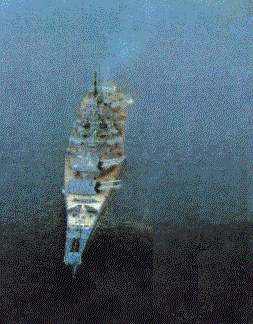 The first battleship battle group (BBBG) deployed to the Western
Pacific in 1986, built around USS New Jersey (BB 62). In addition to demonstrating the desired flexibility and US presence, USS New Jersey's BBBG deployment was an exercise of Navy interoperability with land-based US Air Force units. USS New Jersey's performance during her initial deployment
demonstrated the ability of the modernized battleship to do the job. Her reliability, responsiveness and endurance confirmed their value and the need for battleships in the surface Navy of the 1990s and beyond. During that initial ll-month deployment, which began as a three-month shakedown cruise, USS New Jersey fired her 16-inch guns for the first time since rejoining the fleet at gun emplacements ashore while off Beirut, Lebanon.
The first battleship battle group (BBBG) deployed to the Western
Pacific in 1986, built around USS New Jersey (BB 62). In addition to demonstrating the desired flexibility and US presence, USS New Jersey's BBBG deployment was an exercise of Navy interoperability with land-based US Air Force units. USS New Jersey's performance during her initial deployment
demonstrated the ability of the modernized battleship to do the job. Her reliability, responsiveness and endurance confirmed their value and the need for battleships in the surface Navy of the 1990s and beyond. During that initial ll-month deployment, which began as a three-month shakedown cruise, USS New Jersey fired her 16-inch guns for the first time since rejoining the fleet at gun emplacements ashore while off Beirut, Lebanon.
Despite long-standing private sector interest in obtaining the New Jersey under the donation program, the ship was subject to several administrative and legislative actions that caused it to be taken off, then placed back on, the Naval Vessel Register in the 1990s, before being finally removed in 1999. It was removed from the Register in January 1995 as part of a Navy decision to remove the four Iowa class battleships built for the Navy during World War II.
Section 1011 of the National Defense Authorization Act for Fiscal Year 1996 included battleship readiness requirements to (1) list and maintain at least two Iowa class battleships on the Naval Vessel Register [the official inventory of ships in custody or titled by the Navy] that are in good condition and able to provide adequate fire support for an amphibious assault; (2) retain the existing logistical support necessary to keep at least two Iowa-class battleships in active service, including technical manuals, repair and replacement parts, and ordnance; and (3) keep the two battleships on the register until the Navy certified that it has within the fleet an operational surface fire support capability that equals or exceeds the fire support capability that the Iowa-class battleships would be able to provide for the Marine Corps' amphibious assaults and operations ashore. The Navy placed two Iowa Class battleships [Wisconsin and New Jersey] on the register about 2 years after the act's requirement took effect. Both ships were in good material condition and had been maintained on the register in the highest readiness category for inactive ships. The Navy planned to keep the battleships on the register until its naval surface fire support gun and missile development programs achieve operational capability, which was estimated to occur between fiscal year 2003 and 2008.
Before section 1011 was enacted, the Navy had begun to demilitarize the New Jersey by welding down the training mechanisms of its 16- inch guns. Despite this action, the Navy selected the New
Jersey over the Iowa, which had one of its 16-inch gun turrets rendered inoperable, due to an earlier explosion because repair cost estimates for the latter were greater. In the Strom Thurmond National Defense Authorization Act for Fiscal Year 1999, Congress directed the Navy to substitute the Iowa for the New Jersey on the NVR and to arrange for its donation. One of the legislation's requirements was that the ship be located in New Jersey as a condition of the donation. The Navy made this change in January 1999.
On 20 January 2000, the Secretary of the Navy approved the selection of the Home Port Alliance, a nonprofit organization, to receive the New Jersey under the Navy's ship donation program. The organization had sought to obtain the ship for use as a floating museum to be moored in Camden, New Jersey. The Secretary's decision represented the culmination of a competition between the Alliance and the USS New Jersey Battleship Commission, another nonprofit organization, which had sought to obtain the ship for a proposed museum in Bayonne, New Jersey.
Placed out of commission at Bayonne on 08 March 1968, Wisconsin (BB-64) joined the "Mothball Fleet" there, leaving the United States Navy without an active battleship for the first time since 1896. Subsequently taken to the Philadelphia Naval Shipyard, Wisconsin remained there with USS Iowa (BB 61) until recommissioned again on 22 October 1988. USS Wisconsin returned to war when Iraq invaded Kuwait. In February 1991, Wisconsin fired her 16-inch guns at targets just north of Khafji, Saudi Arabia, the ship assisted shore-based ground units in their tasks. Wisconsin shared gunnery duties with USS Missouri (BB 63). USS Wisconsin was decommissioned for the final time, on 30 September 1991. After being berthed at the Naval Station Norfolk, VA, she was moved on 31 May 2000 to the Norfolk Naval Shipyard. She will be moored in downtown Norfolk as a museum in late 2000.
The Kentucky (BB-66) was built at the Norfolk Navy Yard, Portsmouth, Virginia, but never completed. Her keel was first laid in March 1942. Construction was suspended in June of that year and not resumed until December 1944. Work was again suspended in February 1947. The ship, completed only up to her second deck, was launched to clear the building drydock, so that USS Missouri (BB-63) could undergo repairs for damage received when she went aground on 17 January 1950. Though several schemes were entertained for completing Kentucky as a guided-missile ship, none were pursued. Her bow was removed in 1956 to repair USS Wisconsin (BB-64), and she was sold for scrapping in October 1958. However, Kentucky's engines remain in service to this day, powering the fast combat support ships USS Sacramento (AOE-1) and USS Camden (AOE-2).
Specifications
|
|
Displacement | Light Displacement: 45231 tons
Full Displacement: 57271 tons
Dead Weight: 12040 tons
|
| Length | Overall Length: 888 ft
Waterline Length: 860 ft
|
| Beam | Extreme Beam: 109 ft
Waterline Beam: 108 ft
|
| Draft | Maximum Navigational Draft: 38 ft
Draft Limit: 37 ft
|
| Max Speed | 35 knots
|
| Power Plant | Eight boilers, four geared turbines, four
shafts, 212,000 shaft horsepower
|
| Armament |
32 - Tomahawk ASM/LAM - 8 armored box launchers
16 - Harpoon ASM - 4 quad cell launchers
9 - Mk 7 - 16-inch / 50 caliber guns
12 - Mk 28 - 5-inch / 38 caliber guns
4 - Mk 15 - 20mm Phalanx CIWS
|
| Combat Systems |
SPS-49 Air Search Radar
SPS-67 Surface Search Radar
4 Mk37 Gun Fire Control
2 Mk38 Gun Direction
1 Mk40 Gun Director
1 SPQ-9 [BB-61]
SLQ-25 NIXIE
SLQ-32 EW system
|
| Aircraft | None embarked
landing area and unhangared parking area
4 SH-3 or
4 SH-60
|
| Compliment | 1,515 ship's company
65 officers
1,450
enlisted
58 Marines |
|
|
Builders | New York Navy Yard -- BB 61, 63
Philadelphia
Navy Yard -- BB 62, 64
|

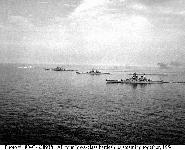
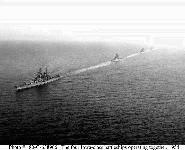
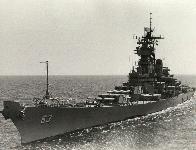

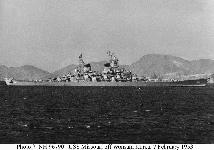

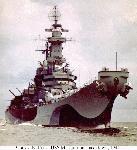
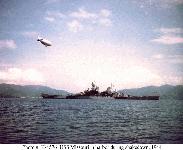
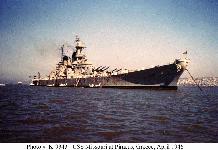
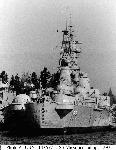
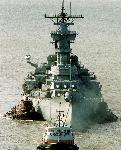
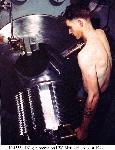
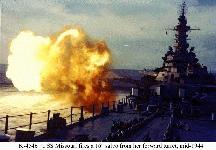
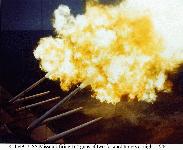
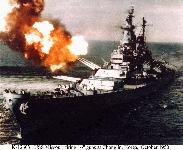
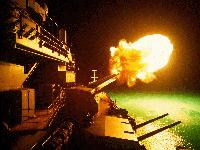
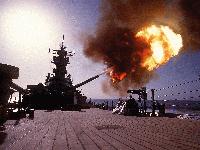
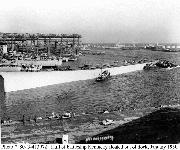
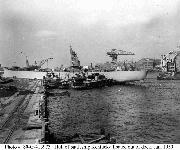
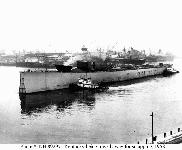
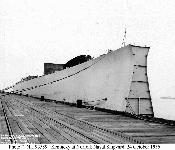
Sources and Resources
http://www.fas.org/man/dod-101/sys/ship/bb-61.htm
Maintained by Robert Sherman
Originally created by John Pike
Updated Saturday, October 21, 2000 7:23:24 PM
 The first battleship battle group (BBBG) deployed to the Western
Pacific in 1986, built around USS New Jersey (BB 62). In addition to demonstrating the desired flexibility and US presence, USS New Jersey's BBBG deployment was an exercise of Navy interoperability with land-based US Air Force units. USS New Jersey's performance during her initial deployment
demonstrated the ability of the modernized battleship to do the job. Her reliability, responsiveness and endurance confirmed their value and the need for battleships in the surface Navy of the 1990s and beyond. During that initial ll-month deployment, which began as a three-month shakedown cruise, USS New Jersey fired her 16-inch guns for the first time since rejoining the fleet at gun emplacements ashore while off Beirut, Lebanon.
The first battleship battle group (BBBG) deployed to the Western
Pacific in 1986, built around USS New Jersey (BB 62). In addition to demonstrating the desired flexibility and US presence, USS New Jersey's BBBG deployment was an exercise of Navy interoperability with land-based US Air Force units. USS New Jersey's performance during her initial deployment
demonstrated the ability of the modernized battleship to do the job. Her reliability, responsiveness and endurance confirmed their value and the need for battleships in the surface Navy of the 1990s and beyond. During that initial ll-month deployment, which began as a three-month shakedown cruise, USS New Jersey fired her 16-inch guns for the first time since rejoining the fleet at gun emplacements ashore while off Beirut, Lebanon.

























